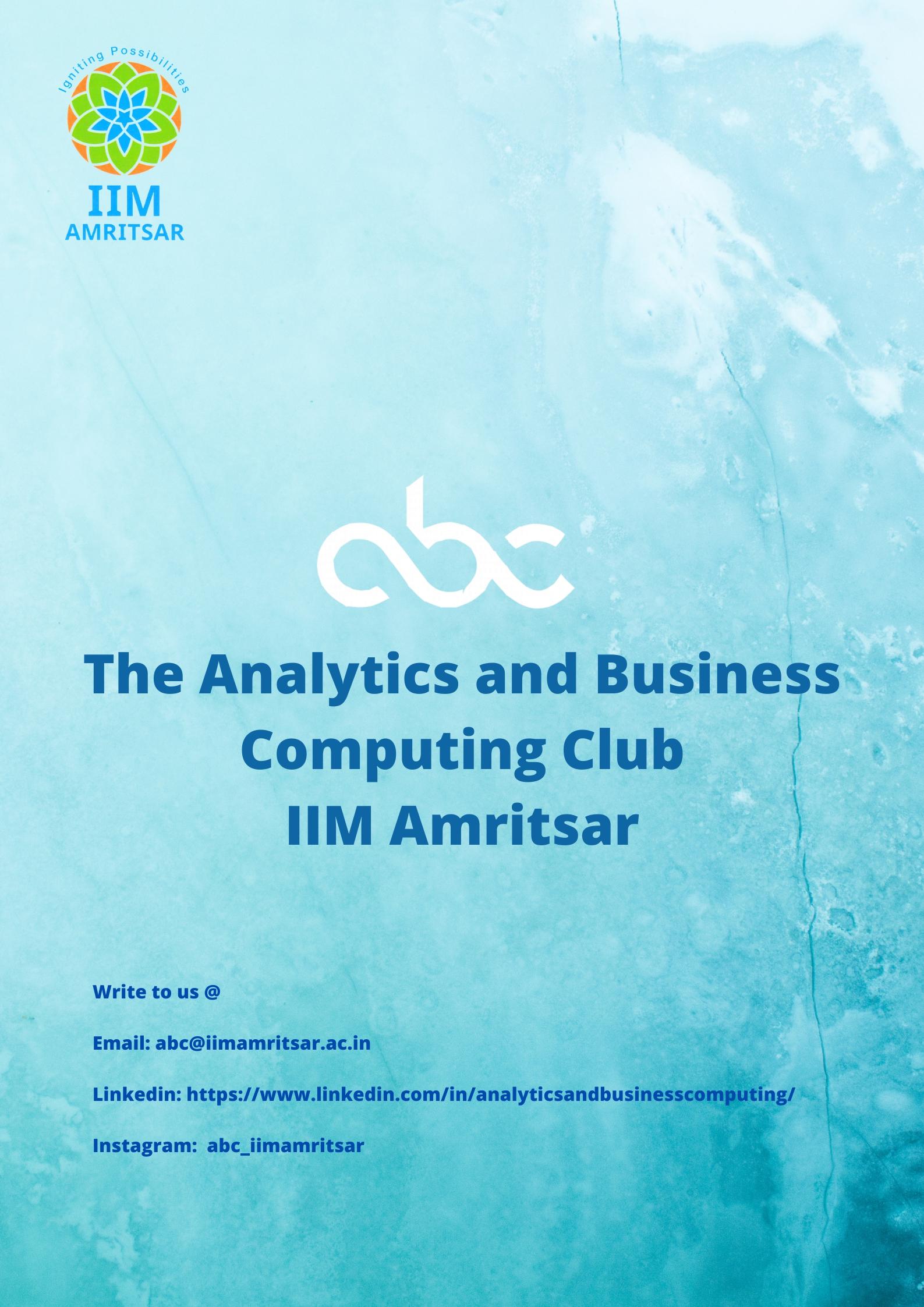

Table of Contents

01 Web3.0:HypeorHope? PAGE04 02 Web3.0&ItsRoleinManagingDigitalTransformation PAGE06 03 TheNextGenerationWeb&ItsPotentialUses PAGE08 04 Web3.0&SemanticWeb PAGE11 05 DecentralizedAutonomousOrganization PAGE14 06 SemanticWebforDigitalGovernment PAGE18 07 ClubActivities PAGE21 08 Vyakriti-TheITandAnalyticsConclave PAGE22 09 OurTeam PAGE23 10 MovieReview:Moneyball PAGE24 11 Crossword PAGE25 12 Quiz PAGE26
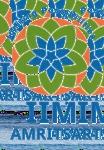
A-GRAM | 03
FacultyCorner
Web3.0:HypeorHope?
Dr. Kalpit Sharma Assistant Professor IIMAmritsar

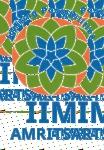
“Many people believe that decentralization means loss of control. That's simply not true. You can improve control if you look at control as the control of events and not people. Then, the more people you have controlling events - the more people you have that care about controlling the events, the more people you have proactively working to create favorable events - the more control you have within the organization.”
- Wilbur L. Creech
Every few years, the technological landscape experiences sudden upheavals forcing technologists and agents alike to adapt. Recently, Web 3.0 has been popular among technology enthusiasts. It is positioned as a decentralized, blockchain-based Internet ecosystem that is operated and governed by its users. But still, a pertinentquestionlingers,whydoweevenneedtorevamptheInternet?IstheInternetbroken?Andshouldfuture managersandtechnologistsmendittopreventthecapitalistforcesfrombreakingitfurther?Bytheendofthis opinionpiece,IhopewecanagreeonsomepremisesforcreatingafairerInternetthroughmoderntechnological artifacts.

Tounderstandtheissueswithtoday'sInternetandbusinessesbasedonit,weneedtorevisitthehistoryofvalue creation by businesses. It is critical to do so because the Internet accentuates the flaws in our business models while,atthesametime,technologicalloopholesinitsarchitectureenablebusinessestopersecutedigitalcitizens. Beforethetechgiantsdominatedourlives,there“were”thebehemothsfromtheindustrialerawhohadperfected mass production and sequential value-creating pipeline businesses. We can still witness the relics of these pipeline businesses in many asset-heavy industries such as defense, aviation, etc. During the peak of the now infamousdot-combubble,manyfirmspivotedtoyetunderutilizedplatformbusinessmodels.Thisprovedtobea robust growth engine for these platform firms because of the massive scope for scalability and outsourcing of criticalvalue-chainfunctions.
Prosumers(i.e.,producersandconsumers)domostoftheworkinsuchbusinessmodels.Yet,mostofthiswork endsupbeingdistributedandmonetizedbybigcompanies,whichkeepmost,ifnotall,ofthemoneyandcontrol forthemselves.Now,weareseeingashiftfromplatformsto “protocols.” Protocols(inconjunctionwithtokens) willchangetheincentivefortheprosumers,asmentionedearlier.Unlikeplatforms,protocol-basedsystemsdo not participate in policing and verifying transactions or providing market infrastructure. They coordinate transactionsbetweenactors(orpeers)bysettinganeconomicincentive(i.e.,tokens),thatactasrewardstoactors. ButwhataboutWeb3.0?ThecurrentInternetarchitecturepreventsormakesitdifficultforustopivottoprotocolbased business models. The economic incentive is non-existent. Platforms decide what they will keep for themselvesandwhattheypayus.Moreover,untilnow,consumershadtosurrenderdatatotheseplatformgiants, whichcreatesavenuesforprivacyrisks,lossofagency,andcentralizedcensorship.Forexample,asofnow,to bookacab,onehastorelyonride-hailingplatformstomatchdemandandsupply,checkwhetherthedriverisnota criminal,andensurethatthepriceisaffordable.
A-GRAM | 04
Allthesetaskshaveanenormousscopeforarbitragefromtheplatform.Incontrast,imagineyouareonaridehailingblockchainwherepricesandidentityareensuredbyasmartcontractthathasbeenagreedapprovedby peersofthisblockchain.


Thus, Web 3.0 uses open protocols and decentralized, community-run networks that combine the open infrastructure of Web 1.0 with the public participation of Web 2.0.As we might know, blockchain is an open, distributed ledger that can record transactions between two parties efficiently and in a verifiable & permanent way (Tapscott et al., 2019). First, according to experts, Web 3.0 will allow people to monetize their platform activity Peoplecangetpaidtokensfortheirattentiontoplatformactivities.Theircontributionscanbearchived with foolproof provenance with the help of NFTs and crypto assets. Second, Web 3.0 platforms can be democraticallygovernedbyusersaccordingtoagreedrulesofengagement.Nomoreforgettingwhatpermissions yougavetheplatformsandwhethertheycansellyourdata.Forinstance,Twitter,thedebacleofourtimes,would nothavebeensoldofftoanuncertainfutureiffortheprotocol-baseduser-governedideology.
Buthowdoesitallmatter?Asmanagers,one'sfocusshouldbetoseparatehopefromthehype.Theycandecide thiscontingentonthreebroadcriteria.First,howmuchlossdothebusinessandcustomersincurifthedataused for decision-making gets corrupted? Second, if external actors are incentivized to distort or change the data, especiallywhenfirmsorstatescensorpeople'svoices.Lastly,Web3.0technologiesalsowarrantthethoughtof whetherdataintegrityunderminesthetrustneededforyourbusiness.Forexample,newscorporationsorcontentdrivenplatformsneedtoestablishtheveracityofnews/contentpeddledbythem.Thefakenewsontheirplatform infamously positions them as less credible platforms. But, is it? What about the risks of Web 3.0? After all, technologyisasgoodasthepeopleusingit.
Experts have detailed the risks of the blockchain-based Web 3.0 paradigm following the trajectory of similar technologies in the past.Arecent example of the speculatory behavior of bitcoin markets and the collapse of popularcryptoexchangeFTXforcesustobemindful.Therisksarediverseyetcriticaltodecidingthesuccessof Web 3.0. The complexity of previously unheard technology reduces its adoption for controlling essential functionssuchasgovernance,finance,etc.Therefore,withoutanycredibleregulationmonitoringWeb3.0,firms andpeoplelackproofofconcept.Lastly,blockchain-basedWeb3.0needhighamountsofelectricitytopower these systems. That raises its carbon footprint and begs us to do an environmental impact assessment. In conclusion,asmanagers,oneshouldtreadthemurkywatersofWeb3.0carefullywithacleargoalofachieving decentralization,asnoonewantstoberememberedasacautionarytale.
A-GRAM | 05
Students’Corner
Web3.0&ItsRoleinManagingDigitalTransformation
 Mr. Rushikesh Kothawade Student - MBA BA-01 IIMAmritsar
Mr. Rushikesh Kothawade Student - MBA BA-01 IIMAmritsar

Web3 is a technology that will possess decentralization, openness, and transparency, but how? This is how GavinWood,creatoroftheWeb3orWeb3.0phrasein2014,characterizesit.WoodisthefounderofParity Technologies. World Wide Web inventor Tim Berners-Lee initially labelled this new generation of Web technologies the SemanticWeb. It aspires to build a freer, more decentralized internet with an air of refined refinement.Userswilleventuallybeabletodecidehowmuchoftheirdatatheywanttosharewiththirdparties forfinancialgain.
HowisWeb3.0differentfromWeb2.0?
InWeb2,theplatform,cloud,andapplicationdistributionsareallmanagedandoperatedbyasinglegoverning body Distribution of tasks and peer-to-peer interaction are expanding in prevalence in the Web3 Edge architecture.Web2transactionsareconductedusingfiatcurrenciessuchastheIndianRupee.Web3allowsthe useofcryptocurrency,orencrypteddigitalcurrency,topayforpurchases.Examplesofcryptocurrenciesare Tether,Ethereum,andBitcoin.
CookiesareusedfortrackingandcustomizationpurposesinWeb2.InWeb3,userscanacquireNFTs,whichare digitaltokenswithaspecificvalueorsetofperkstiedtothem.Web2isdefinedbyitsadvancedlayouttoolsthat allow for more variable customization than Web1. Web3 is characterized by autonomously intelligent technologieslikeAIandmachinelearning.OnWeb2.0,databasesserveasthebackboneforapplicationsand content.TheimmutabilityprovidedbyablockchainisputtouseinWeb3.Web2.0enabledtheriseofsocial networkingsiteslikeMeta(i.e.,Facebook)&Twitter
SalientFeaturesofWeb3.0:
DAOs:Web3.0introducesanewformoftheregulatoryframeworkforonlinebusinessesandservicesknown asdecentralizedautonomousorganizations(DAOs).Likeblockchain,DAOsmakecrucialdecisionsthrough peerreviewratherthansomecentralcommittee.Web3.0isprojectedtofostertheexpansionofdecentralized financial services that bypass traditional banking institutions, having far-reaching consequences for the internationalmonetarysystem.

By encouraging the development of decentralized applications that use blockchain & smart contracts, decentralizationwillenabledistributedapplicationsacrosstheWeb3.0environment.AsWeb3.0evolves,its coreprinciples,suchasdecentralization,automation,andintelligence,willlikelyremainconstants.
DAOs'networkarchitecturecomplementsWeb3'sgroundwork,enablingafutureeconomybasedoncreators and innovators. Decentralized autonomous organizations (DAOs) are already a part of Web3 if we count decentralization among the new internet's crucial features. DeFi, for one, employs DAOs to facilitate the genuinely decentralized nature of platforms. Significant instances of DAOs in Web 3.0 are decentralized exchangeslikeUniswap&SushiSwap.
A-GRAM | 06
TheWeb3eragaverisetonon-fungibletokens,decentralizedautonomousorganizations,andthemetaverse, all of which share similarities and can be categorized together. Both promote user autonomy and asset ownership by relying on decentralized technologies like cryptocurrencies and sharing other commonalities like decentralized community management and alternative fundraising strategies that bypass traditional venturecapital.
Blockchain&Artificialintelligence:Thissystemencryptsandsecuresuserinformation.Thispreventslarge tech companies from gaining access to and/or misusing users' private information. By combining semantic abilitieswithhumanlanguageprocessing,computerscanreaddataalmostaswellaspeople,allowingforfaster andmoreaccuratesolutions.

Awidevarietyofdevices,notjustpersonalcomputersandmobilephones,canconnecttotheinternetanytime andanywhere.Web2.0iswidespreadinmanyareas,butitsprominencewillincreasedramaticallywiththe proliferationofIoTdevices.

Computernetworkdesignthatisdecentralized:Edgecomputinggathers,stores,andprocessesdatanear theclient,whereitisgenerated,ratherthansendingittoacentralizeddatacentreforprocessing.Thisisthe foundationofWeb3.0,whichmanagesinformationandapplicationsonhigh-techgadgetslikesmartphones, laptops,andcars.
3D Capabilities: With Web 3.0's 3D graphics capacity, we may now experience a new, more immersive dimensionofthevirtualhorizon,onethatblurstheborderbetweentheactualandtheabstractworlds.Many industries have found practical applications, from e-commerce and video games to medicine, real estate, museumtours,andmore.
UseCasesofWeb3.0:
Banking&FinanceintheThirdGenerationoftheWeb:Whentransferringmoneyonlinetoday,reputable institutions like banks and PayPal are required. With web 3.0, powered by blockchain technology, you can instantlysendmoneytoanyoneelseonline.Thewidespreadadoptionofblockchain-basedfinancialservicesis a real possibility. Financial institutions can stream data to theWeb 3.0 community without relying on third parties.
MarketingintheWeb3.0Era:DatacollectedfromusersisavaluablecommodityintheWeb 2.0 era. Swindles involving online advertising are also relatively widespread. These fraudulent advertising practices involve the fabrication of impressions and click to defraud advertisers by charging them for nonconvertingtraffic.WithWeb3.0technology,consumerswillhavecompletecontrolovertheirdata.Itwillbeup
A-GRAM | 07
Students’Corner
TheNextGenerationWebInfrastructureandItsPotentialUses
Mr. Deepak Ranjan Nayak Student - MBABA-02 IIMAmritsar

Data centres across the world with powerful computing capabilities are supplemented with data spreadacrossawiderangeofdigitalsourcessuchas smartphones, PCs, smart appliances, sensors and vehicles.Itisestimatedtoproduceandconsume160 timesmoredatain2025ascomparedto2010.
The new buzzword in the tech and capital world is Web 3.0. It is the third generation of the internet. It realizes the technology in a more distributed and democratic way With efficient machine learning algorithms, Web 3.0 will use encryption to connect datafrompeople,companies,andmachines.Thiswill lead to the rise of completely new markets and businessmodels.“Returntotheglobalvillage”isthe end result immersed daily in the human-centric and highlypersonalisedinteractionsattheglobalscaleof theinternetandsupportedbyever-expandinghuman andmachineskills.
Web1.0isbasicHTMLcontrarytothedecentralized versionofWeb3.0.Itisanewversionoftheinternet whereanyonecancodeandbuildtheirownplatform havingrequisitetechnicalskills.
ThereisalotofscepticismregardingWeb3.0beinga reality.Ithasadimensionwhichwillgivethecontrol of data to the users. Users generating are the proprietorship of their data. They can even sell to firmsinaspecificfield. Itwillrestrictthemonopoly ofdataanditsmisusebytechgiantsacrosstheworld using Web 2.0 which runs on platforms such as JavaScriptandHTML.Itisanopenanddecentralized ecosystem based on the blockchain. The technology
will enable to exchange money and information withouttheneedformiddlemensuchasbanksortech companies. With the advent of Web 3.0, we won't havetogothroughanyfee-chargingintermediariesto communicatewithanypersonormachineanywhere in the globe. This change will pave the way for an entirely new class of companies and market structures, from worldwide cooperatives to autonomous, decentralised organisations and independent data exchanges. Contrary to Web 2.0 where the user is the product for firms to thrive on user-generateddata,Web3.0willencompassusersto beownersofdata.Hypothetically,Userswillbeona single platform where they can move from social media,email,shopping,keepingpersonalandpublic recordsintheblockchain.
Web3.0enablestheminimisationoftrustrequiredfor coordination on a global scale. This marks a move towards trusting all constituents of a network implicitlyratherthanneedingtotrusteachindividual explicitly and/or seeking to achieve trust extrinsically.

Through'modernmutual'ownershipandgovernance of these new decentralised systems of intelligence and sophisticated & dynamic economic incentives, network participants can collaborate to solve previouslyintractableor'thinlyspread'problems. The forthcoming wave of Web 3.0 goes far beyond theinitialusecaseofcryptocurrencies.
The technological innovation of Web 3.0 is built on threenewlayers:

1. Edgecomputing.
2. Decentraliseddatanetworks.
3. Artificialintelligence.
A-GRAM | 08
Web 3.0 is based on blockchain technology. The technology stack consists of infrastructural and functionallayerswith5-layerarchitecture,L0toL4.

L0 provides network capabilities necessary to build peer-to-peer networks which consist of peer-to-peer internetoverlayprotocols(likeDevp2p,Libp2p)and platform-neutral computation description language (suchasEVM,WASM,UTXO)
L1 provides the functionality of distribution and interaction which includes zero/low-trust interaction protocols, data distribution protocols, zero/low-trust interaction platforms and transient data pub/sub messaging.

L2 provides enhanced features such as scaling, computingandencrypting.
L3ishuman-readablelanguageandcodelibrariesthat make development easier using protocol-extensible developerAPIs and language (like Web3.js, ether.js, Solidarityetc.).
L4 is for user interaction encompassing protocolextensible user-interface cradle (e g Status, Metamasketc.).
InWeb3.0,thereisnolongeranyneedfora centralisednetworkservertokeeptheback-end logic,nodatabasetocentrallysavethestateofthe application,andnoadministrativecentre..
Thespaceisutilisedbytheprogrammearchitect. Blockchainisadistributedledgertechnologythatis usedtocreateinternet-basedappssuchasDApp. DAppruinsadecentralizedandimmutable blockchainnetwork.Itwritestransactiontermsinto codethroughsmartcontractsusinganautomatic executionagreement.Bothpartiescandotheir transactionwithouttrust.
NewDigitalEconomy
Asocialrevolutionisunderwaywithgreater decentralization.Itisdrivenlargelybytechgiants suchasFacebook,Amazon,Apple,Netflixand Google.
· Financialservicestransformation
Tokenization is spawning new economies in the context of Web 3.0, DeFi, and even the Metaverse. They are essentially developing digital "alternative economies" alongside conventionalones.
· NFT(Non-FungibleToken)
A digital asset that can be transferred, sold, mortgaged, lent, or kept for their own appreciation.Itisanewwaytomakemoney by selling their works without relying on intermediaries.
· DAO(DecentralizedAutonomous Organisation)
Aneworganizationgovernancemodelbuilt aroundtransparencyandinclusiveness.
· GameFi(ChainGames)

Itisamodelthatintegratesgamesand financebuiltonblockchaintechnology.It representsaDecentralizedfinancialproduct intheformofgamesandgamifiestherule ofDeFi.
· Tokenization
Thetechniqueofissuingtokensrepresenting anasset,withtheasset'srulesandbehaviours contained in a blockchain-based smart contract. To put it another way, an asset can eitherbefungibleornon-fungible.Theassets that fall under the category of "fungible" cannotbedistinguishedfromoneanotherand can be used in place of one another. Nonfungibleassetscan'tbeexchangedforsimilar ones, hence they have to be labelled in a specialway
A-GRAM | 09
· Smartcontracts
Without an intermediary, a blockchain can store programmes that automate the implementation of an agreement. Participants transmit instructions in a high-level language that construct programmes to executeatransaction.

· Crowd-sourcing theparticipationofalargenumberofpeopletoobtaininformationorperformatask,anexamplebeing crowdfunding.

· DecentralizedData(DeData) appsbuiltonWeb3.0usingtokenisation,smartcontractsandotherdecentralisedcomputeandstorage protocolstodeliveraservice.
ThedifferentWeb3.0andDeFiparticipants,rangingfrompeer-to-peeruserstogovernmentorganisations.

A-GRAM | 10
Students’Corner
Web 3.0 & Semantic Web
Mr. Ravi Consul Student - MBA08 IIMAmritsar
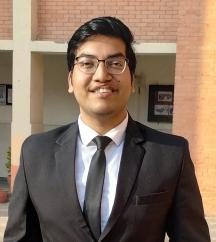
Oftenthesedays,wehearaboutWeb3.0fromthe tech-savvycrowdandhowtheyemphasizethatitwill shapethefutureoftheInternet.Also,mostofus associateWeb3.0withjustCryptocurrenciesand Metaverse,butinreality,thereismoretoitthatwe willdiscussfurther.
BeforeexplainingwhatWeb3.0is,someofyoumight bewonderingwhatWeb1.0andWeb2.0waswhichis completelygenuinegiventhemyriadofresources online.

Web1.0
WhatwetermasthefirststageoftheWorldWide Webwhichrangedbetween1991and2004,wasan erawithafewcreatorsandahugecustomerbase consumingtheircontent.Thereusedtobe static pages,meantforonlytheconsumptionofdatawithno advertisements.
Web2.0

ThelimitationsofWeb1.0wereaddressedin2004 andtheneedforamoreinteractiveserviceincreased. Web2.0,alsocalledparticipativesocialweb highlighteduser-generatedcontent,usabilityand interoperabilityfortheendusers.Now,peoplecan sharetheirthoughtsonthewebsitesandcollaborate withotherusers.
AlthoughWeb2.0wasabreakthroughininternet history,itdidhavesomelimitations.Itrestrictedthe entirepowerandcontrolofdatatothehandsofafew capitalists.Thisincreasedthedependenceandreduced thepotentialofInternetusage.
Web3.0
Nowthatwehaveunderstoodwhatwerethe limitationsofWeb1.0and2.0,nowisagoodtime tointroduceyoutoWeb3.0formally.Itwas coinedbyGavinWoodin2014withtheideaofa decentralizedinternetwherethepowerisnot limitedtojustafewcapitalistsbutspreadacross multiplesystems.

Itworksprimarilyonblockchaintechnologyand isanetworkofvariouspeer-to-peernodesthat workindependentlyacrosstheglobe.Toretain ownershiprightswiththepeople,ituses cryptocurrenciesandNon-FungibleTokens (NFTs).
So,essentially,Web1.0wasaread-only,Web2.0 areadandwriteandWeb3.0isaread,writeand owntechnology.
Now,thatwehaveunderstoodwhatWeb3.0is,it willbeniceifwecangetthroughwhereitcanbe usedandwhat'sinitforindividualslikemeand you.
A-GRAM | 11
Someofitspopularfeaturesofitarelistedbelow-
SemanticWeb

Itisthestudywhichenablesthecomputertoanalysehugeamountsofdatatounderstandthemeaningofthe wordsratherthanfocusingontheworditself.


Forexample,let'sconsidertwosentences,
· IloveWeb3.0
· I<3Web3.0

Essentially,bothstatementsmeanthesamebutaredifferentintheirwordusage.Therefore,thesemanticswill treatthemasthesamebecausetheemotioninbothissimilar.
Now,youmightbewonderingwhereweuseit.Today,searchenginescanrecursivelyscanthroughthelinks ofbillionsofwebpagestoindextheircontent.Therefore,apersonjustlikeusperformingasearchwillgeta listofclassifiedresultsinorderoftheirrelevancesowegetthebestresults.
A-GRAM | 12
Tocreatesuchapowerfultechnology,itusesthreestandards
ResourceDescriptionFramework(RDF)

ItistheprimarylanguageoftheSemanticWeb.Itadoptsagraphmodelwhoseobjectiveistoclassifythe resourcesontheInternet(e.g.,Companies,Books,Articlesetc.)

SPARQLProtocolandRDFQueryLanguage(SPARQL)
ItisaquerytoprocessthedatafromtheRDFtoprocessitforfurtheruse.
WebOntologyLanguage(OWL)
Itisalanguagefocusedtodisplaycomplexdatastructuresaboutobjecthierarchiesandrelationships.
SemanticWebforDigitalGovernment

OneofthemajorapplicationsoftheSemanticWebcomeswiththeformationofDigitalGovernment.Now, thisissomethingwhichwedon'thearcommonlyasit'sintheveryinitialstage.
Intoday'stime,weallknowhowtousethe“Signinwith…”optionwhenweareusinganyonlineservice. Suppose,youwanttoreadanewsarticleonanewwebsite,youimmediatelytaptheSignInoptionand withinseconds,youcanreadit.Soundseasyright?
Butinreality,theregistrationismuchslower Thereisnosharedviewof“You”usingtheseservices.Youare requiredtore-registereachtimeyouuseanewserviceandthereisnolinkingbetweentheseprofilesalthough it'sthesameperson.
Thisisoneofthemanyissuesthegovernmentsaretryingtosolvetoensurethesafetyoftheircitizens'data andmaintainhassle-freecommunicationacrossmanygovernments.
Therefore,SemanticsWebcomestotherescuehere.Whatitoffersistheabilitytounderstandthesemantics ofdata,andlinkdocumentswhichcanenablethemachinestoexchangeinformationwithoutexplicitly programmedtotalkwitheachother.SomeofitsapplicationsarealreadyinplacebyAppleandGooglebut theSemanticWebreducesthedependencyoftheseplayerstomanageyourdataandgivesmorecontrolover theuser.
Now,let'sseewhatisitforthegovernmentinthis
A-GRAM | 13
Students’Corner
Decentralized Autonomous Organization
Ms. Oindrila Mondal Student SCMHRD Pune

TheenvisionistohaveafullyoperationaldemocracydesignedfortheDecentralizedAutonomousOrganization. (DAO)thatcanevolvealongwiththespatialwebtechnologystackofWeb3.0.Theanimatedshortfilm “Dinnerforfew”byNassosVakalis[9]flawlesslycapturestheinfirmityofthecentralizationofpower.Ina fullydecentralizedsystem,decisionsaretakeninaconsensusmannerwithouttheinterventionofthe bureaucracy
TheconceptofdecentralizationinDAOisfuelledbyblockchainanddistributedledgertechnologies. Originallyblockchainwasintroducedin1991topreventtamperingwiththetimestampofdigitaldocuments. SatoshiNakamotolaterusedittopowercryptocurrencyin2009.Cprogramminglanguageintroducedusto pointers.Blockchainisachainofblocksconnectedlikepointers.Eachblockhasdata,hash,andhashofthe previousblock.Thefirstblockisknownasthegenesisblock,whichhasastartingaddress.Hashesareunique andcanbeconsideredfingerprintstoidentifyaparticularblock.Hash0to3areuniqueidentifiersofeach block.TheDatadependsonthecontextwherethechainisbeingused.Inbitcoin,thedataholdstransaction recordsofthesenderandreceiver.TheDatatierofWeb3.0harnessesthispowerofblockchainand distributedledgers.
BlockchainArchitecture-



A-GRAM | 14
TheDAOisautonomousduetoalgorithmsthatcanworkontheirownbasedonsmartcontracts.Smart contractsarenothingbutbusinessintelligencerulesasdesignedbyhumanstrategists.Oncethesmartcontract rulesarecreated,itbecomesimmutable.InthelogicaltierofWeb3.0,Cognitivecomputing,aformof ArtificialIntelligence,helpsthestrategisttoanalyzethroughsimulationsandadaptthebestdecision-making rules.WewillstrikethesmartcontractwiththecompetenceofQubitsofQuantumcomputingandcognitive intelligencesothatitself-initiatesandself-learnsinanautonomousfashionintheworldofSpatial computing[1].


TheQubitistheunitofQuantumComputingjustlikea“bit”istheunitofdigitalelectronics.TheQubithas powertomaplocationintheSpatialComputingworld.ThespatialprotocolorHyperServiceTransfer Protocol(HSTP)isthespatialcousinofHyperTextTransferProtocol(HTTP)ofthedigitalworld.[1]
TheWeb3.0technologystackisnecessaryforDAOtobesuccessfulbecauseDAOisnothingbutanonline decentralizedinstitutionwhereeveryparticipantlocatedgloballyhaveagreedupontransparent,automated andopen-sourcesetofruleswrittenassmartcontracts.Therulesarecreatedbymembersthroughconsensus process.Thereisnocentralpower.Forexample,imaginetheonlineshoppingplatform,MyntraasaDAO. TheratinggivenbycustomerstoproductsofMyntracreatesavaluetoeachoftheproduct.Bydrawingupon specificfeedbacksgiventhatfeedbackiscompulsoryforeverypurchase,avaluesystemiscreated.Thevalue ofaparticipantinMyntradependsontheratedinteractionswithothermembers.

A-GRAM | 15
TheparticipantmemberreceivestokensbasedonthevaluecreatedforMyntrathroughasharedperspective. Thus,adiverseperspectiveoftheparticipantshelpstocreateadecentralizedorganization.DAOisaselfregulatingsocialsystem.Therequirementforanintermediarygoesawaywhenproductsareadvertisedand sentdirectlyfromtheproducertothecustomer.[3]
TheadvantageofDAObecomesthedisadvantageofDAObasedoncases: Collectivedecision-makingbymembersenjoyingequalrightsinthevotingprocessisaspecialtyofDAO.It becomesadisadvantagewhenthe participant member group is not large, diverse, and known toeachother, andthentheymightmutuallyinfluenceeachother.Thus,electionriggingcansetbackthevotingmechanism thatisattheheartoftheDAO.
ThetransparencyofrulesisanadvantageofDAO.Thebusinesslogicisopen-sourceinaledger;henceany bugisidentifiablebythepublic.Thewrongverificationinapeer-to-peernetworkisalsopunishedby decreasingthetokenvalue.Businessescompetingwitheachotherforclientswillnotparticipateinprocesses wheretheirbusinesslogicanddataarenotkeptconfidential.

NotallorganizationscanreapthebenefitsofDAObutcollectivedecision-makingjobslikegovernment electionpaperworkintribunalsystemscanexperimentwithDAOasasupportivemechanismtofacilitatein thedecision-makingandassignmentofassets.Letusseetheindustriesthatcangetdisruptedby DAO.
Banking:DAOcanhelpinbankingtheunbanked.Example:DAOorganizationsusedblockchaintoaidinthe Syrianrefugeecrisis.Bitcoinhelpstosendmoneyimmediatelybasedondigitalidentificationandtimestamp. ABRAusesbitcoin-basedremittanceservices.Barclaysusesblockchaintomakesecurepayments.[4]

SupplyChainManagement(SCM):Transactionsaredocumentedtransparentlyinthepublicledgerthatcanbe monitoredtomanagewaste,time,cost,labourandemissions.
Betting:AugurisaDAOaimedtocreatedecentralizationinforecastingfromsports,andstockstoelections.
InternetofThings:ADEPTisaproductofIBMandSamsungthatisacentralizedlocationforcommunication ofIOTdevices.Oncetheygetregisteredinthelocalblockchainthroughvendorsandusers,thedevicescan connecttootherdevicesinthenetwork.Thus,falseclaimofreplacementbytheuseranddenialofvendor servicecanbeprevented.[5]
A-GRAM | 16
Insurance:EtheriskhasitsownDecentralizedInsuranceProtocolforWeather,crop,flightdelay,andsocial insurance.[6]AlongwithAonandOxfam,itisdevelopingblockchaincropinsuranceforSriLanka.Thus, rulesgettingmappedonalgorithmsinaworldwheremachinescantalktoeachotherhelpstocutthecostof intermediarylawyersandthecomplexityofverificationsystems.[7]



Transportation: La'Zoozpayscoders,drivers,andothercontributorsthroughZoozcoins.La'Zoozisa decentralized,community-ownedplatform,unlikeothercentralizedplatformsthatrequireheftycharges havingnocommunitypower.[8]
InthecomingyearswewillseemoreDAOcomingupwiththeirowncurrency.Governancewillnotget disruptedbutconstitutionallawsneedtobeamendedtofacilitatetransparency(throughDAOandrecognized cryptocurrency)wherecollectivedecisionmakingisrequiredandconfidentialityisnotcompromised.
A-GRAM | 17
Students’Corner
Semantic Web for Digital Government
Ms. Deeksha Shukla Student IETLucknow
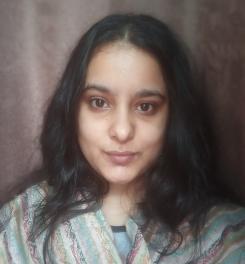
One of the most definitive foundations supporting trust is transparency. Currently, however, in our day andage,thereliesapoignantdifficultyinseeingthis level of openness that digital and electronic systems requiretofunctionwithoutahitch.UnderSection2-j oftheRTIActof2005,isstatedtherightto'Obtaining information in the form of diskettes, floppies, tapes, video cassettes or in any other electronic mode or throughprintoutswheresuchinformationisstoredin acomputerorinanyotherdevice.'
Officials find it difficult to be able to comply with suchdemandsatalltimes,especiallywiththeonsetof Web3.0andthesemanticweb.
SemanticWebandWeb3.0
TheSemanticwebis'avisionofnewarchitecturefor theWorldWideWeb,characterizedbytheassociation of machine-accessible formal semantics with more traditional web content.' (Kumbhar, Kumbhar et al., 2009) It better enables humans and computers to workincooperationandwasfirstgivenreferencetoin 'The Semantic Web', by Tim- Berners Lee, 2001 whereintheconceptwasintroducedbymeansof'web agents' which understood complicated instructions and manipulated information meaningfully Today, those 'web agents' are Siri and Cortana. Ontological languages - Darpa agent modelling language, Resource description framework (RDF) - have been developedbytheW3Ctoestablishrelationsbetween groupsofitemsforincreasedintelligenceinsystems.
1:The
attheXML2000conference

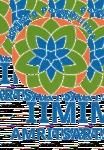
Takingastepback,Web3.0isthesuperset,containing thesemanticweb,andelementsofWeb1.0andWeb 2.0. It underscores a decentralized and transparent mechanism for user interaction with the web. Transactionrecordsaremaintainedonadigitalledger which is visible to all users. Further, it is able to interpret the data according to the context given. Blockchainframeworks,IoT,smartcontracts,etc.are allfeaturesWeb3.0uses.
For example, the sentence "DrVikram Sarabhai was borninAhmedabad"onawebpagewillbeannotated, connecting a person with their birthplace. This level oftechnologyisobservedbyprivatetechcompanies but government sites are not able to make use of it. Neithercanweseelog-inoptionsbeingmoreversatile

A-GRAM | 18
Fig
SemanticWeblayercakepresentedbyTim BernersLee
ingovernmentsites,asisthecaseinotherwebsites.
DigitalGovernmentanditsmodernization
E-government also known as “digital government” can be defined as the civil and political conduct of government using information and communication technologies(ICT)(McIver&Elmagarmid,2002).
Governmentsworldwidearefacingdecreasinglevels of public trust [1], this is mainly due to a tussle between the data privacy heralding public and the socialmediagiantsfavoringtheexactopposite.Web users want to be assured that their data is safe and is being used to simply increase user interaction rather thantokeepaneyeonallonlineactivities.Thatiswhy thelinkingofAadharcardswithmobilenumberswas so strongly disapproved of by the Indian public (Henne,2019).Similarly,thisalsorelatestoMAANG companiesdealingwithconsumerprivacylawsuits.
In turn, this begs the question of whether or not governmentsshouldfocusonadaptingsemanticweb protocols.Wouldthebenefitsoutweighthenegatives, ifany?
AgovernmentperspectiveontheSemanticweb
Cross-ministerial services can be digitized and expanded via the use of blockchain technology. For digital platforms, blockchain can reduce the cost to startupnewmarketplaces,aswellasauditthevalidity oftransactions(CatalineandGansetal.2016)

Someapplicationsworldwideofblockchainservices have found global use cases as can be seen from the table.
Table 1: Blockchain Use Cases Adopted by Governments and the Focus of Blockchain Applications
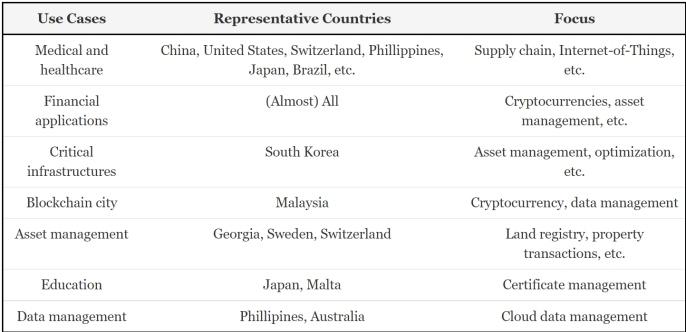
Webservicesandbusinessprocessesarebeingusedto addressserviceaccessibilityandintegration.Bringing intelligence to information has necessitated the incorporationofsemanticsintocontentasmeta-data, mostlyXML-based,aswellasassociatedprocessing techniquesthatallowthatmeta-datatobeinterpreted.

The inclusion of the semantic web in digital government services means tailoring them to the needsofcitizens,businessesandcommunities.Some elementsofthesemanticwebarealreadybeingused in government-built e-platforms, however, many moreinitiativesareyettobetaken.
Fig2:E-governmentmodel

A-GRAM | 19
The advantages of such digital governance would include: accessibility of services, information 'intelligent' systems,accuratedatacollectionmechanisms,secureassetmanagement,speedyserviceprovisions,etc.Further, decentralizationcanconsequentlynegatethemonopolizationofpowerbybigTechgiants(Nicolas,2020).
Adoptingthesemanticweb

There lie some challenges in adopting the semantic web. They are Scalability of Semantic Web Content, OntologyAvailability,DevelopmentandEvolution,Multilingualism,etc.(Benjaminetal.)
However,asdeliberatedbyvarioussources,itisnecessarytoadoptsomeformofthesemanticwebtointegrate government services provided online. Governments must play at the same level as private companies to be compatible with the user's increasing needs. In India, steps such as online renewal and registration of several services,tokenizationofbankcredentialsinpaymentplatforms,mandatinganationaldigitalcurrency,etc.have beentaken.Thereisinvariablymoretobedone.

Conclusion
Thedigitalgovernmentmustevolverapidly.Althoughthesemanticwebisacomplexdomain,effortsmustbe made to inculcate it within digital government.As before mentioned in this essay, it will boost transparency, improvetheintegrationofservicesandnegatethehegemonyoftechgiants.Althoughresearchsuggeststhatthere isalotofroomforfurtherbetterment,thenotionmustatleastbeconsidered.
A-GRAM | 20


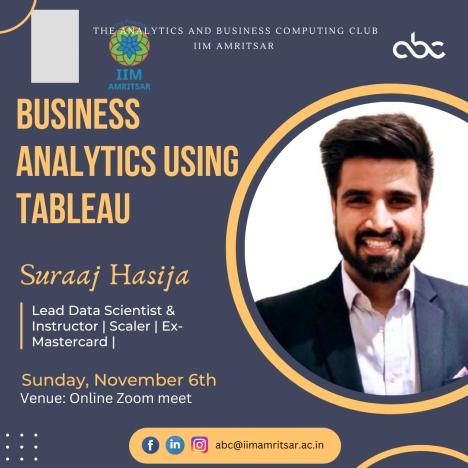



A-GRAM | 21
W-INNINGS BUSINESSANALYTICS USING TABLEAU
CRACK.XLSX
ClubActivities
VYAKRITI-The ITandAnalyticsconclave
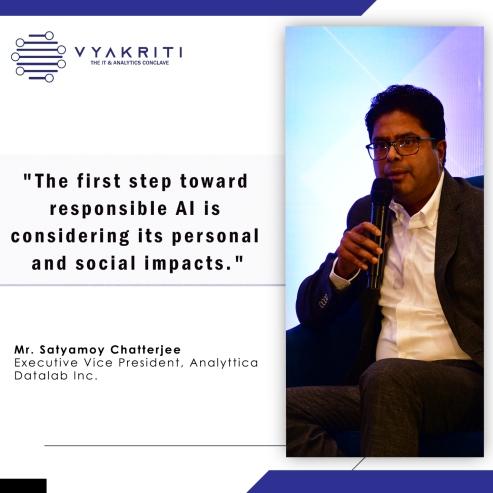

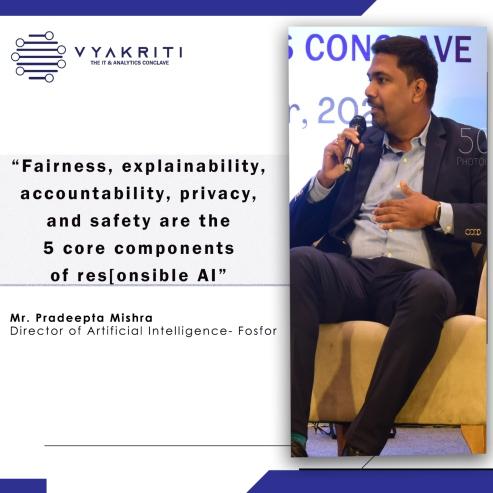
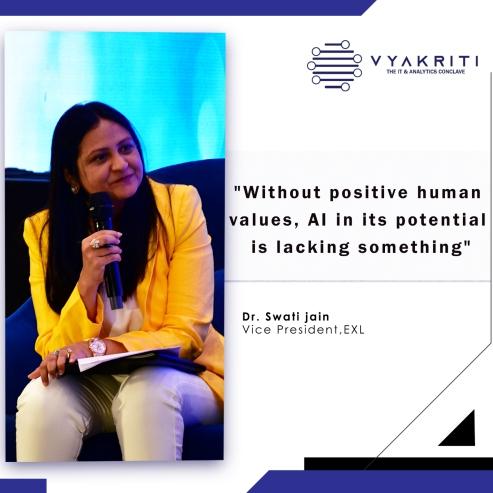
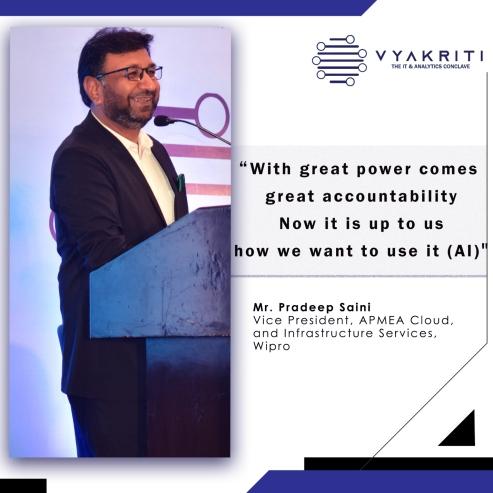

IIMAmritsarconductedits2ndITandAnalyticsconclave-Vyakriti.Thethemeforthisyearwas “InnovatingwithConscience:DesigningandDeployingResponsibleAI” PanelDiscussionrevolvesaroundthemeaningofresponsibilityofAI,toolsforbuildingresponsibleAI, managerialroleinitsdeploymentetc.
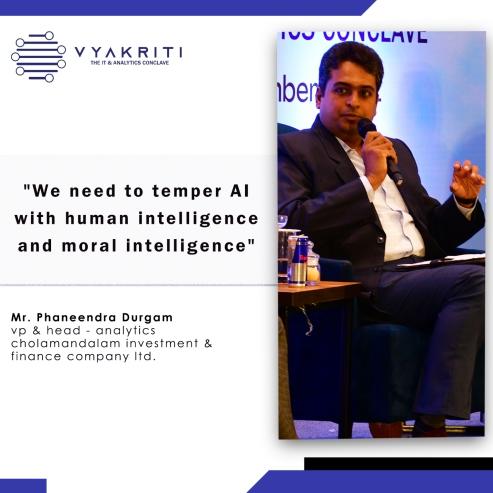

A-GRAM | 22
OurTeam










Senior Coordinators


A-GRAM | 23
Vaisakh B S Nirbhay Kamble
Pousali Mondal
Nitesh Chandra Sangeetha Nair
Mayur Badhan Aditya Gupta
Junior Coordinators
V NAS Sunil Kumar Chatrathi Soham Sarkar Sethu KS
MovieReview
In2002season,thenation'slowest-salariedMajorBaseballteamputtogethera20-gamewinningstreak,settinga newAmericanLeaguerecord. Sameseasonteamlossesfirst11gamesinrow ItisonthecharacteroftheOaklandAthletics'generalmanagerBillyBeane(BradPitt),whoafterabadstart asaMLBplayer,movedovertomanagement.Inpreviousseason,he'dtakentheA'stotheWorldSeries,only tohavethemloseandseetheirtopthreeplayershiredawaybyricherteamsofferingbiggersalaries.
Rebuildingtheteamatbargainbaseprices,BeanebecamepersuadedbythemoneyballtheoriesofPeter Brand(JonahHill),anerdyYalegraduatewhocrunchednumberstoarriveatacost-benefitanalysisof baseballplayers.

Usingmoneyballtheoryanddataanalytics,Beaneboughtthebestplayershecouldwithanextremelylimited budgetforpayroll.Withapprox.$41minsalary,theOaklandA'steamultimatelycompetedwithlarger marketteamssuchastheYankees,whospentover$125minpayrollduringthe2002baseballseason.


Exactlyhowdidhedoit?
Beaneperformeddataminingonhundredsofplayers,identifyingstatisticsthatwerehighlypredictiveofhow manyrunsaplayerwouldscore.Thesestatisticsweren'tnecessarilynumbersthatbaseballscouts traditionallyvalued.Insteadofcompetingforhigh-pricedhome-runhitterswithhighbattingaverages,he soughtlower-costplayerswithhighon-basepercentages.Histheorywasbasedonplayerswithahigheronbasepercentagewouldbemorevaluablethanplayerwithloweron-basepercentageevenwhenthosewiththe lowerpercentageultimatelyhitmorehomerunsandwerefasterandevenstronger.
A-GRAM | 24
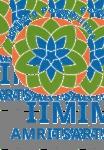

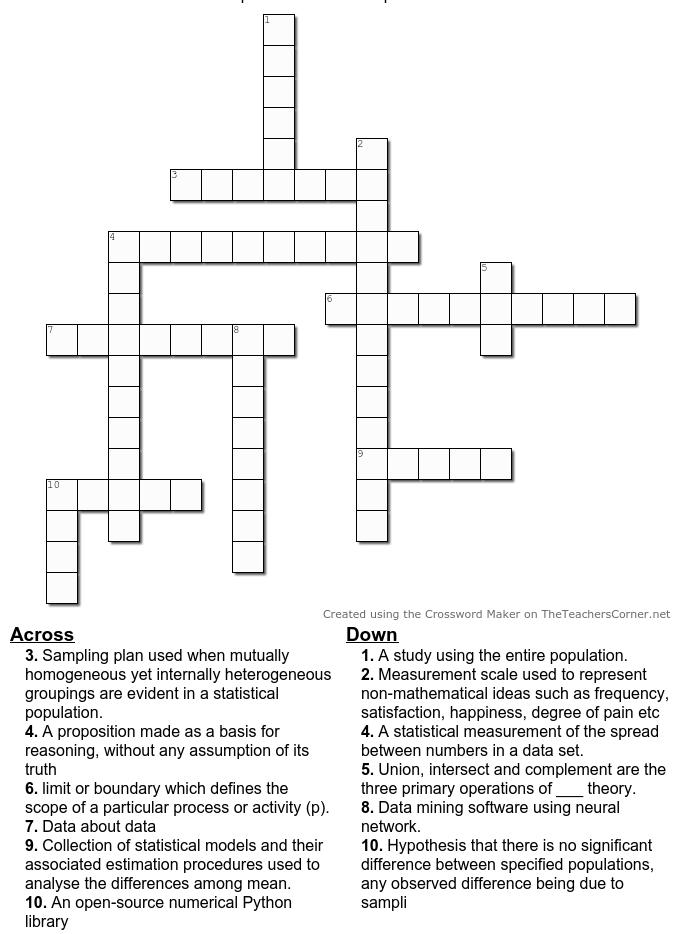
A-GRAM | 25 Crossword
Quiz
1. Aproposedexplanationforaphenomenonis
a. Correlation b. R-Square c. Hypothesis d. P-Value 2. Amathematical tool that is used to determine whether the outcome of an experiment is the result of a relationship betweenspecificfactorsormerelytheresultofchance a. Correlation b. P-Value c. R-Square d. StatisticalSignificance 3. Thebranchofdataanalyticsconcernedwiththepredictionoffuturepossibilitiesandtrends_________ a. PrescriptiveAnalytics b. PredictiveAnalytics c. DescriptiveAnalytics d. DiagnosticAnalytics 4. A voluminous amount of structured, semi-structured, and unstructured data that has the potential to be mined for information a. SmallData b. BigData c. MetaData d. StatisticalData 5. WhichofthefollowingistrueaboutMEAN? a. Exactmiddleofthebellcurve. b. Sumofallobservation–MEAN=0 c. Mostfrequentlyrecordedobservation d. Noneoftheabove 6. Theshapeofanormaldistributioncurvedependson a. Quartiledeviation b. Mean c. Standarddeviation d. Variance 7. A:F-Distributioncannottakenegativevalue. B:ThereisonlyOneparameterinF-Distribution. a. AistrueandBisfalse. b. AisfalseandBistrue. c. AandBbotharetrue. d. AandBbotharefalse. 8.Theabsolutemeasureofdispersionis a. Coefficientofdispersion b. Variance c. Coefficientofskewness d. Standarddeviation

Scan for answer


A-GRAM | 26
